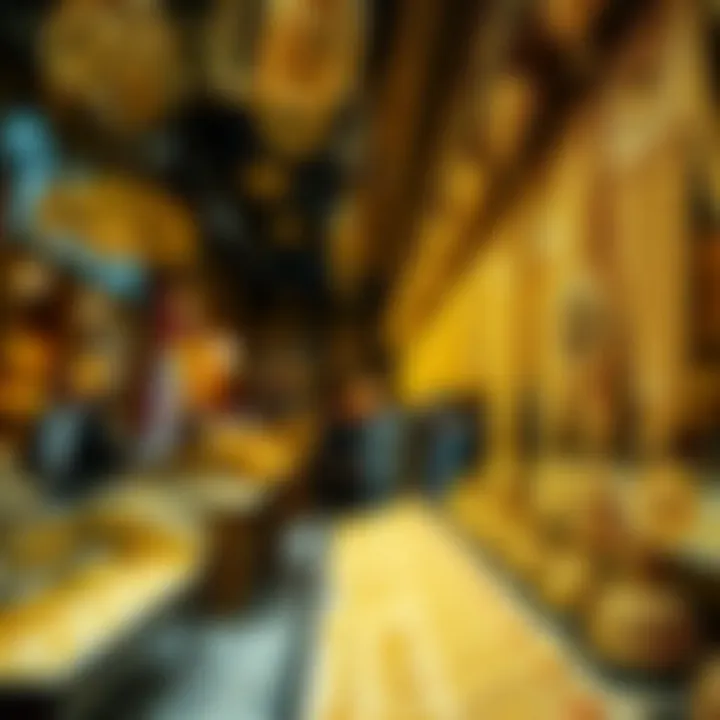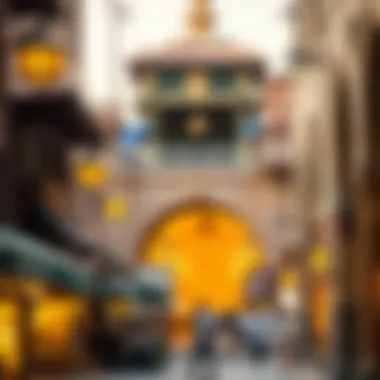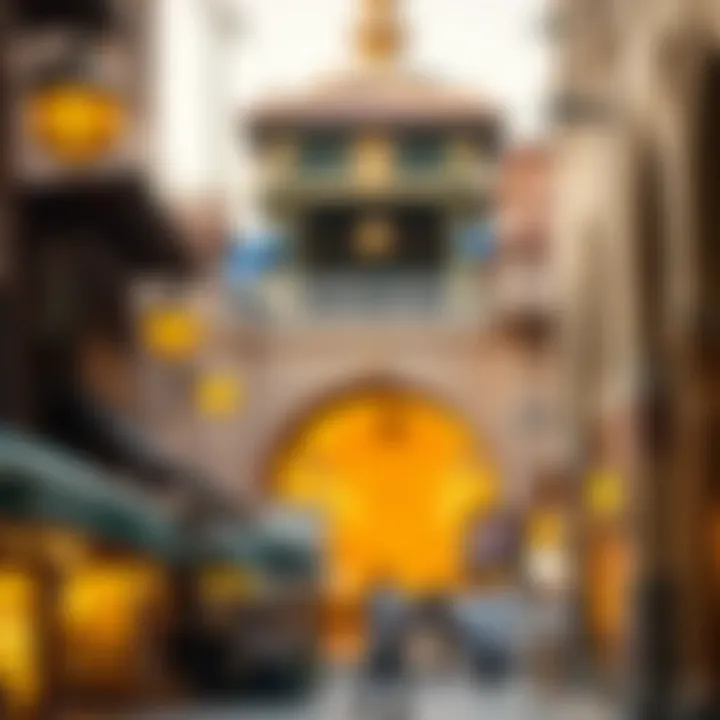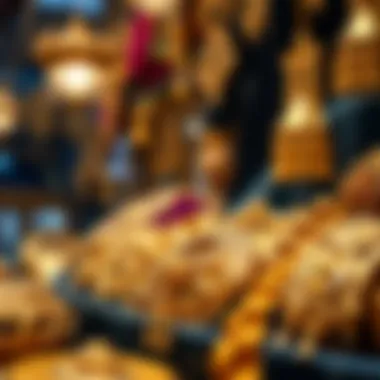Exploring the Gold Souk in Dubai: A Jewel in the UAE


Intro
Nestled in the heart of Dubai, the Gold Souk offers more than just a chance to buy glittering jewelry; it's a gateway into a world steeped in history, culture, and economic vitality. This bustling marketplace isn't merely a center for commerce—it's a living artifact of the United Arab Emirates' trade legacy. As you wander through its narrow alleys, your senses are awakened by the glimmering gold, tantalizing aromas of spices, and the animated chatter of vendors and customers alike.
The Gold Souk stands as a testament to Dubai's transformation from a humble fishing village to a global hub for luxury and wealth. With over 300 retailers, most of which are family-owned businesses, it represents a vibrant sector within the country's economy, fueling not only the jewelry market but also contributing significantly to tourism and overall marketplace dynamics. The intricacies of negotiating prices, understanding quality, and discerning craftsmanship add layers to the shopping experience that are both educational and rewarding.
This article will take you on an insightful journey through the historical significance of the Gold Souk, its impact on the economy of the UAE, and the cultural narratives that it upholds. By examining how this marketplace attracts both tourists and investors, we will explore its crucial role in Dubai's identity, specifically within the real estate and economic landscape.
Thus, unpacking the layers of the Gold Souk means finding out how vibrant it is, not only as a shopping destination but as a key player in the larger narrative of Dubai and the UAE. Get ready to delve deeper into this jewel of Dubai, discovering the factors that make it a must-visit site for those intrigued by the interplay of commerce, culture, and history.
Intro to the Gold Souk
The Gold Souk, an iconic marketplace in Dubai, stands as a powerful symbol of the city’s rich trade heritage and opulent lifestyle. This bustling bazaar is not just about buying gold; it embodies the narrative of Dubai's transformation from a modest fishing village to a global city teeming with luxury and innovation. For real estate agents, investors, and property seekers, understanding the Gold Souk offers insights into the economic vitality of the region. The brilliance of this gold marketplace reverberates through Dubai's economic landscape, making it a pivotal point for understanding the allure of the Emirati lifestyle.
Defining the Gold Souk
The Gold Souk is a sprawling labyrinth of shops, each overflowing with a stunning array of jewelry crafted from gold, silver, and other precious gems. It is situated in the district of Deira, a place historically known as a trading hub in Dubai. Here, a visitor can find everything from intricate traditional designs to contemporary pieces that are striking and bold. The allure of the Souk lies not only in the precious metals but also in the experience. Strolling through its narrow alleys, one is enveloped by the shimmering sights and the delightful chaos of haggling, chatter, and laughter. This marketplace offers a vivid glimpse into local culture while also attracting tourists and investors alike who appreciate fine jewelry.
Historical Context
To truly appreciate the Gold Souk, one must inspect its historical roots. The market has been in existence for decades, evolving both with time and alongside Dubai's own rapid development. The trade of gold began gaining momentum in the early 20th century when the discovery of oil altered the region’s economic landscape dramatically. Dubai transformed into an essential stop for merchants who traveled across the Arabian Peninsula and beyond. Gold became a revered form of currency, and as the trade flourished, the Souk grew to become a central player in the local economy.
The historical significance of the Gold Souk cannot be overstated. During the 1980s and 1990s, it saw substantial growth as wealth influx from oil exports led to an insatiable demand for luxury items. The market’s architecture, vibrant with Middle Eastern influences, narrates stories of traders and customers over centuries. Countless artisans, many of whom have been in the trade for generations, showcase their craftsmanship here. This connection to the past enriches the experience of visitors today, who come from far and wide to engage with not just the products, but the traditions that lie behind them.
Architectural Features of the Gold Souk
The Gold Souk in Dubai is not merely a marketplace for gold; it is an architectural marvel that weaves together tradition, culture, and modernity. The unique blend of design elements reflects the rich history of the region while showcasing the city’s rapid development. Understanding the architectural features of the Gold Souk is vital for grasping its significance, not just as a shopping destination but also as a cultural hub that attracts tourists and investors alike.
Traditional Design Elements
Stepping into the Gold Souk is akin to walking into a bygone era. The traditional design elements create a sense of place that is both nostalgic and captivating. Key features include:
- Arched Canopies: The souk is characterized by its stunning arched walkways that provide shade while enhancing aesthetic appeal. These arches have practical applications, offering shelter from the blistering sun while allowing for breezy airflow.
- Intricate Tile Work: The flooring often showcases gorgeous patterns made up of colorful tiles; this not only adds vibrancy but reflects the artistic heritage of the UAE.
- Wooden Screens: Traditional wooden mashrabiya screens, used for ventilation and privacy, can be spotted throughout the area. These elements connect visitors with Islamic architectural traditions, revealing a rich cultural tapestry.
These features collectively evoke a sense of authenticity, breathing life into the marketplace and making every corner a photographic postcard. The architectural choices are not incidental; they are carefully designed to tell a story, inviting customers to engage with the space beyond just a transactional experience.
Modern Innovations
While the Gold Souk pays homage to its historical roots, it also embraces contemporary architectural innovations. These modern touches serve both functionality and aesthetic purposes, making the marketplace not only a place to shop but an experience in itself. Some notable innovations include:
- Eco-Friendly Materials: In a nod to sustainability, many stalls have introduced green building materials that reduce the environmental impact. This shift resonates with today’s conscientious travelers and reflects a broader movement towards sustainable practices.
- Digital Integrations: Several shops have begun to incorporate technology to enhance the shopping experience. Digital screens display prices in real-time, and some vendors offer online shopping options, blending traditional purchasing methods with modern conveniences.
- Artful Lighting Design: The clever use of lighting elevates the ambiance and accentuates the glimmering gold on display. Well-placed lights draw attention to intricate pieces, creating a visual feast that captivates visitors.
The fusion of modern and traditional architecture within the Gold Souk is a testimony to Dubai's dynamic identity. Rather than disregarding its past, the souk honors it, ensuring that visitors can appreciate both the legacy and the evolution of this iconic marketplace.
Economic Importance of the Gold Souk
The Gold Souk in Dubai is not just a market for visitors; it is a cornerstone of the local economy. This bustling marketplace serves as a vibrant epicenter for the trade of gold, precious metals, and jewelry, contributing significantly to Dubai's financial landscape. The economic significance of the Gold Souk encompasses various aspects, from providing livelihoods to thousands of individuals to generating substantial revenue that bolsters the entire emirate's economy.


Role in the Local Economy
At the heart of Dubai's local economy, the Gold Souk plays a crucial role by creating a ripple effect that affects employment, tourism, and local businesses. The souk houses hundreds of shops, offering an array of gold products that cater to both locals and tourists alike. This amalgamation of commerce supports thousands of jobs, directly employing shopkeepers, designers, and craftsmen, along with a whole network of auxiliary services such as security, transport, and logistics.
Additionally, the souk is a magnet for tourists. Visitors flock to the Gold Souk, not just to purchase gold but to experience the cultural richness of Dubai. This influx of tourists boosts spending in hotels, restaurants, and other attractions, further enhancing the local economy. According to recent tourism statistics, the Gold Souk draws millions of visitors annually, making it an indispensable facet of Dubai’s tourism sector.
Moreover, the Gold Souk functions as a vital commerce hub combining various elements of trade. Non-locals often seek to invest in gold, perceiving it as a stable asset amidst economic fluctuations. This, in turn, solidifies Dubai's standing as a reputable trading post in the global gold market and attracts international investors.
Impact on Global Gold Trade
The Gold Souk's economic influence extends far beyond the borders of Dubai and even the UAE. It is pivotal to the global gold trade, shaping prices and trends across international markets. With Dubai being regarded as a key player in this arena, the business practices developed at the Gold Souk have a profound impact on global gold pricing.
For instance, many gold traders in the souk establish their prices based on international rates but adapt them according to local demand and supply. The unique blend of traditional trading techniques with modern market strategies helps maintain a competitive edge in the global market. In recent years, the souk has also embraced digital platforms, allowing for an increase in online transactions, thus broadening its reach.
Additionally, events like the Dubai Jewelry Show not only spotlight the Gold Souk's offerings but also connect international buyers with local sellers, fostering more substantial global partnerships in the gold industry. The souk’s reputation has made it a go-to market for high-quality gold and artisanal jewelry, attracting clients from around the world.
"Dubai's Gold Souk is more than just a marketplace; it's a linchpin of economic activity that shapes both local and global gold trading trends."
All these elements underscore the critical importance of the Gold Souk in the local and global economic narrative. Its continuous evolution reflects broader economic patterns and trends, making it a fascinating subject for further exploration.
Cultural Significance of the Gold Souk
The Gold Souk in Dubai is much more than just a marketplace; it is a cultural landmark that embodies the spirit of the United Arab Emirates. At first glance, it might appear overwhelmed by bling and glitter, yet it is the tapestry of tradition, community, and craftsmanship that truly defines its cultural significance. Exploring this vibrant bazaar reveals layers of social customs and artistic heritage woven into the very fabric of Dubai's identity.
Social Gatherings and Traditions
In many ways, the Gold Souk acts as a vibrant social hub where locals and visitors alike converge, sharing stories, bargaining over prices, and enjoying the bustling atmosphere. This marketplace is a reflection of the community's values, where the ritual of buying and selling transcends mere transactions, transforming into an experience of camaraderie and interaction.
Social gatherings within the souk are a norm; families often come together to shop for significant life events such as weddings and anniversaries. It’s in these moments that cultural practices come to life, with gold jewelry playing a pivotal role. For instance, during wedding season, the souk buzzes with activity, showcasing traditional pieces that symbolize wealth, beauty, and status—often adorned with intricate designs that showcase the skill of local artisans.
"Buying gold in the souk is similar to more than a shopping trip; it's a rite of passage that connects generations through style and tradition."
Local markets like the Gold Souk also nurture the cultural heritage of the UAE through festivals and events that celebrate this rich history. During these festivities, one can witness live demonstrations of traditional crafting techniques, where artisans showcase their talents in working with precious metals. Such events not only draw attention to the importance of traditional craftsmanship but also reinforce the community's appreciation for their heritage.
Artisan Craftsmanship
At the heart of the Gold Souk lies the artistry of its jewelers. Each piece of jewelry is a testament to the skilled artisans who dedicate hours, sometimes days, to finest details. Goldsmithing is not merely a trade here; it’s an art passed down through generations, where each artisan adds their touch to designs that reflect cultural narratives.
The craftsmanship seen in the Gold Souk is diverse:
- Traditional Designs: Inspired by rich Arabic calligraphy and geometric patterns.
- Modern Innovations: Incorporating contemporary styles while maintaining a local flair.
Many artisans display unique techniques, such as hand-hammering and filigree, where fine gold strands are twisted and woven to create intricate designs. Visiting these craftsmen gives an intimate look at the dedication and precision that goes into each piece.
Visitor Experience at the Gold Souk
Visiting the Gold Souk isn’t just about shopping; it’s a full-fledged experience that immerses you in the local culture and vibrant atmosphere. This marketplace is a hub where you can witness the hustle and bustle of traders and buyers, adorning gold and precious stones under the gleam of warm lighting. The sensory impact is immediate, with the shining displays enticing visitors and blending with the rich aromas of street foods nearby. Such an experience allows you to appreciate not only the products on offer but also the art of negotiation that’s deeply embedded in this setting.
Exploring the Marketplace


The architecture of the Gold Souk is reminiscent of traditional Middle Eastern souks — narrow lanes winding through a maze of shops adorned with golden treasures. As you explore, you’ll find stores offering everything from intricately designed gold necklaces, bracelets, to exquisite earrings. Each item holds its own story, crafted by skilled artisans who often showcase their work at the storefronts.
When walking through, keep your eyes peeled for unique designs that reflect different cultural influences. For example, you might come across Arabic-style pieces featuring geometric patterns alongside more contemporary designs.
Plus, don't hesitate to strike up a conversation with shop owners. Many are happy to share their knowledge about the gold trade and the distinct styles they offer. It is a good chance to bond, learn, and possibly uncover hidden gems that might not be on your radar at first.
Tips for Bargaining
Bargaining is an art form at the Gold Souk, and understanding how to navigate this can enhance your shopping experience. Here are some practical tips:
- Know the Gold Rate: Before you walk in, check the current market price of gold. This will help you talk numbers confidently during negotiations.
- Start Low: It’s customary to begin your offer below the asking price. Lowballing often prompts the seller to counteroffer, and this dance continues until you find a mutually beneficial price.
- Be Patient: Take your time and don’t feel pressured to agree quickly. Show interest, but also exhibit a lack of urgency in your decision-making. Sellers appreciate buyers who show they know what they’re doing.
- Stay Polite: A friendly demeanor goes a long way. Building rapport can yield better deals, as sellers are often keen to make a sale to a pleasant customer.
- Factor in Extras: Sometimes, sellers will throw in extra items or services, such as cleaning or adjustments. Don’t be shy to ask if they can provide additional value to your purchase.
Keep in mind, the experience at the Gold Souk sticks in the mind for far more than the allure of gold; it’s a vivid, almost theatrical display of trade and tradition that defines much of Dubai's unique charm. By embracing both the marketplace dynamics and the cultural context, visitors can achieve an enriching buying experience, perhaps walking away not just with jewelry, but with stories and memories as shiny as the gold itself.
Safety and Regulations
The Gold Souk in Dubai isn't just a dazzling showcase of glimmering gold and intricate jewelry; it also operates under a framework of safety and regulations that help maintain the integrity of the marketplace. For anyone stepping into this vibrant marketplace, understanding these laws and guidelines can ensure a smoother experience and instills a sense of confidence in both buyers and sellers alike.
As the saying goes, "better safe than sorry." This rings especially true in a bustling marketplace where significant transactions take place. Knowing the law protects buyers from potential scams and enables the merchants to operate with assurance in a regulatory environment. Essentially, navigating the Gold Souk follows the principle of being well-informed.
Understanding Local Laws
Local laws in Dubai govern many aspects of the Gold Souk. These regulations are not arbitrary; they exist to ensure fair practices and uphold the reputation of the trade environment. For instance, laws regarding the purity of gold—often measured in karats—require that sellers provide accurate information regarding the quality of the jewelry. Each gold piece must bear a stamp that certifies its authenticity.
It's crucial to remember that the authenticity of items can greatly affect their value. The Department of Economic Development (DED) in Dubai oversees such regulations, making sure that standards are upheld to protect consumers and businesses alike. A savvy shopper should always look for these certifications before making a purchase.
Additionally, trade laws also cover aspects like pricing transparency and fair competition, providing a level playing field for all market players.
Guidelines for Buyers
When it comes to buying in the Gold Souk, it's one thing to admire the bling, but knowing how to navigate the buying process is equally essential. Here’s a list of useful guidelines for buyers to keep in mind:
- Verify Authenticity: Always check for the certificate of authenticity and karat marks on gold items.
- Research Prices: Before you step foot into the souk, do a little homework about the current gold prices. You can easily find this information online, which provides a solid baseline for your bargaining.
- Bargaining: Haggling is part of the culture in the Gold Souk. Don't shy away from negotiating prices; it’s all part of the experience. Start lower to allow room for negotiation.
- Be Informed About Local Norms: Understanding local customs can ease your interactions with vendors. For instance, the practice of saying 'no' initially before agreeing is quite common in negotiations.
- Keep Valuables Safe: Amidst the hustle and bustle, it's wise to remain vigilant about your belongings. Using a secure bag or wearing a fanny pack can help mitigate risks of theft.
Keeping these tips in mind will not only enrich your experience but also help you make safe and informed choices during your visit to the Gold Souk.
"Information is power; ensuring you have it at the Gold Souk will enhance your journey through this glittering realm."
Comparative Analysis with Other Markets
The Gold Souk in Dubai stands out among other global gold markets due to its unique blend of traditional craftsmanship and modern commercial practices. Within this context, a comparative analysis highlights pivotal differences in pricing strategies, customer experiences, and cultural significance.
Global vs. Local Gold Prices
When diving into the intricacies of gold pricing, it's crucial to understand how the Gold Souk compares to markets elsewhere. Global gold prices are driven by a myriad of factors including supply and demand, market fluctuations, and geopolitical events. However, local prices within the Gold Souk may diverge due to factors like regional demand or bespoke craftsmanship.
- Global Prices: These are often listed in international exchanges, reflecting the standard rates per ounce. Prices can shift rapidly, influenced by market news, currency values, and economic forecasts.
- Local Prices in Dubai: Generally, shoppers in the Gold Souk will find prices slightly higher than global averages. This is often due to the intricate artistry involved in local pieces, as well as the reputation of Dubai as a luxury destination.
Moreover, buyers can experience unique benefits in Dubai, including:


- No Tax on Gold: Unlike many countries that impose sales taxes, Dubai's market provides tax-free purchases.
- Competitive Pricing: Vendors often engage in price negotiations, allowing savvy buyers to secure deals that might not be available elsewhere.
- Variety: The Gold Souk showcases an array of styles and designs that are rare to find outside the UAE.
“Understanding these differences not only aids in informed purchasing decisions but also enriches the overall shopping experience in the Gold Souk.”
Unique Offerings in Dubai's Gold Souk
The allure of the Gold Souk is rooted in its distinctive offerings that set it apart from competitors like those in India or Turkey. Each store brimming with shimmering gold pieces tells a story of craftsmanship and culture that one can hardly find elsewhere.
- Custom Jewelry: Many shops allow for the crafting of personalized pieces, which is often more tailored than the mass-produced jewelry found in other markets.
- Cultural Artistry: Traditional Emirati designs, such as the Khaleeji gold, reflect local heritage and craftsmanship that one cannot simply overlook. This captures not only gold but an entire spectrum of cultural narratives.
- High-Quality Assurance: The Dubai government is known to enforce strict regulations regarding purity standards, meaning each piece usually stands up to international standards, often certified to be 18 karats or above.
As the market evolves, new trends are emerging. Innovations in design, such as digital displays for customer convenience or online purchasing options, are becoming more prominent. The vibrant environment is punctuated by local artistry, turning every shopping trip not just into a purchase, but an exploration of the rich cultural tapestry that defines Dubai’s Gold Souk.
By delving into these comparative aspects, one gains a broader appreciation for not just the prices, but also the fundamental uniqueness of the Gold Souk. It’s a market that does more than bind commerce; it encapsulates the essence of its culture, shaping the experience of each visitor.
The Future of the Gold Souk
As Dubai continues to evolve as a global trade hub, it’s crucial to look towards the future of the Gold Souk. This marketplace is not just a collection of shops selling gold; it represents an intricate tapestry of culture, economy, and craftsmanship. Understanding what lies ahead for the Gold Souk offers valuable insights for investors, real estate agents, and enthusiasts of luxury goods.
Emerging Trends
The dynamics of the marketplace are shifting due to several emerging trends. First, there’s an increasing integration of technology in transactions and customer experiences. Many shops are now adopting digital payment methods and online sales platforms, facilitating a seamless shopping experience for customers who prefer to browse online before making a purchase in person. Moreover, the rise of cryptocurrencies as a viable form of payment is gaining traction among traders and buyers.
Secondly, there is an environmentally-conscious shift influencing the sourcing of gold. Jewelry made from ethically sourced gold is becoming more popular, and consumers are increasingly looking for transparency in the supply chain. This shift compels retailers to rethink their sourcing practices, ensuring that they meet the demands of upscale clients who value sustainability.
Finally, the aesthetic appeal of the Gold Souk is likely to adapt as fashion trends evolve. Jewelers are crafting pieces that blend traditional styles with modern touches, catering to a younger audience that cherishes unique and custom designs. From minimalistic gold chains to elaborate statement pieces, the Souk continues to showcase the evolving tastes of its buyers.
Investment Opportunities
As we peer into the future, numerous investment opportunities present themselves within the Gold Souk. With the increasing international interest in Dubai as a trading center, investing in gold-related businesses may yield significant returns. Buyers and investors might consider purchasing from established vendors with a reputation for quality and reliability. These well-regarded shops often provide excellent return policies to reassure savvy investors.
Investing in the property surrounding the Gold Souk stands out as another lucrative opportunity. Given the projected growth in tourism and shopping, real estate in the area is expected to appreciate. Investors could look into commercial properties, short-term rentals, or developments that cater to tourists seeking unique experiences in Dubai.
With both the technology sector and sustainable practices on the rise, savvy entrepreneurs could also think about launching startups that provide supporting services to the Souk. This could range from digital marketing services for jewelers to mobile apps that offer virtual tours or localized offers.
To sum it up, while the Gold Souk may have a rich history, its future is bright. By understanding and adapting to emerging trends and capitalizing on investment opportunities, stakeholders can find ways to thrive in this iconic marketplace as it continues to enchant visitors and investors alike.
As the Gold Souk evolves, staying ahead of the trends is not just beneficial, it’s essential for anyone involved in its vibrant economy.
Finale
As we reflect on the multifaceted allure of the Gold Souk, it becomes evident that this marketplace is more than just a hub for trading gold and jewelry. It serves as a pivotal intersection of culture, history, and economy within the United Arab Emirates. The Gold Souk not only embodies the rich heritage of trade in the region but also positions Dubai as a prominent player in the global gold market.
Summation of Key Points
The journey through the Gold Souk has revealed several key insights:
- Historical Significance: The Gold Souk has roots deep in Dubai's trading past, showcasing how commerce thrived here long before the city's skyscrapers took shape.
- Economic Role: It plays a critical role in boosting the local economy by attracting tourists and investors, serving as a touchstone for high-value transactions in gold.
- Cultural Importance: It is a melting pot of traditions where bargaining isn't just a method of purchase but an essential part of the shopping experience.
- Visitor Engagement: Like a treasure map for explorers, the Souk offers insights into local craftsmanship and unique pieces, inviting all to immerse fully in its ambiance.
In summary, the Gold Souk is not merely a market; it's an embodiment of Dubai's identity, showcasing the vibrancy of its culture and economy.
Calls to Explore
For those considering a visit, whether for personal curiosity or investment purposes, the Gold Souk simply cannot be overlooked. Here are some compelling reasons to experience it firsthand:
- Cultural Immersion: Walking through the souk, one can feel the history and hustle that has defined Dubai's trading roots for generations.
- Investment Potential: With fluctuating gold prices, there are opportunities here for savvy investors to snag attractive deals. The closest thing to a gold mine lies in its countless shops that offer both luxury and craftsmanship.
- Artisan Insights: Engage with local artisans and jewelers who are willing to share the stories behind their creations, providing a deeper understanding of the craftsmanship involved.
- Unique Offerings: The Gold Souk presents a chance to find pieces that tell stories unique to this region, making imports or generic shops pale in comparison.







